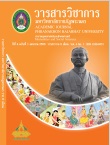การประยุกต์ใช้หลักโยนิโสมนสิการในการแก้ปัญหา การเรียนของนักศึกษาระดับอุดมศึกษา
Keywords:
โยนิโสมนสิการ, ปัญหาการเรียน, การประยุกต์, Yonisomanasikāra, learning problems, ApplicationAbstract
การวิจัยในครั้งนี้มีวัตถุประสงค์เพื่อศึกษา1) ปัญหาและการแก้ปัญหาการเรียนของนักศึกษาระดับ อุดมศึกษา 2) หลักโยนิโสมนสิการในพระพุทธศาสนา เถรวาท 3) การประยุกต์ใช้หลักโยนิโสมนสิการในการ แก้ไขปัญหาการเรียนของนักศึกษาระดับอุดมศึกษา และ 4) นำเสนอแนวทางและการสร้างองค์ความรู้ใหม่ เกี่ยวกับรูปแบบการประยุกต์ใช้หลักโยนิโสมนสิการใน การแก้ปัญหาการเรียนของนักศึกษาระดับอุดมศึกษา โดยใช้ระเบียบวิธีวิจัยเชิงคุณภาพแบบเอกสาร และ บูรณาการด้วยการวิจัยเชิงคุณภาพแบบวิจัยภาคสนาม ผู้ให้ข้อมูลสำคัญ ได้แก่ นักศึกษามหาวิทยาลัยราชภัฏ พระนคร ระดับปริญญาตรี ภาคปกติ ตั้งแต่ชั้นปีที่ 1 ถึงชั้นปีที่ 4 จำนวน 10 คน เครื่องมือที่ใช้ในการวิจัย คือ แบบสัมภาษณ์เชิงลึก การวิเคราะห์ข้อมูลโดยการ วิเคราะห์เนื้อหา แล้วนำมาใช้ในการจัดทำรูปแบบ สำหรับ การประยุกต์ใช้หลักโยนิโสมนสิการในการแก้ปัญหา การเรียนของนักศึกษาระดับอุดมศึกษา
ผลการวิจัยพบว่า
1. สาเหตุของปัญหาการเรียนมีทั้งหมด 5 ด้าน ได้แก่1. ด้านเจตคติเชิงลบในการเรียน 2. ด้านการ มีสมาธิสั้นต่อการเรียน 3.ด้านแรงจูงใจใฝ่สัมฤทธิ์ต่ำ ทางการเรียน 4. ด้านความวิตกกังวลเกี่ยวกับการเรียน และ 5. ด้านบริหารเวลาที่ไม่มีประสิทธิภาพ
2. หลักโยนิโสมนสิการ มีรูปแบบวิธีคิด 10 ประการ ได้แก่ 1. วิธีคิดแบบสืบสาวเหตุปัจจัย 2. วิธี คิดแบบแยกแยะส่วนประกอบ 3. วิธีคิดแบบสามัญ ลักษณ์ 4. วิธีคิดแบบอริยสัจจ์/คิดแบบแก้ปัญหา 5. วิธี คิดแบบอรรถธรรมสัมพันธ์ 6. วิธีคิดแบบเห็นคุณโทษ และทางออก 7. วิธีคิดแบบรู้คุณค่าแท้ – คุณค่าเทียม 8. วิธีคิดแบบเร้าคุณธรรม 9. วิธีคิดแบบอยู่กับปัจจุบันและ 10. วิธีคิดแบบวิภัชชวาท
3. การประยุกต์หลักโยนิโสมนสิการในการแก้ไขปัญหาการเรียนนั้นจะต้องใช้วิธีคิดที่สอดคล้องกับตัว ปัญหาจึงจะเกิดประสิทธิผล เช่นการประยุกต์หลักโย นิ-โสมนสิการด้านเจตคติเชิงลบในการเรียนนักศึกษา ต้องวางท่าทีที่ถูกต้องต่อเจตคติเชิงลบในการเรียน โดย วางกรอบวิธีคิดตามกิจในอริยสัจ
4 แล้วปฏิบัติตาม ลำดับวิธีคิด โดยเริ่มตั้งแต่ วิธีคิดแบบวิภัชชวาท วิธีคิด แบบสามัญลักษณ์ วิธีคิดแบบสืบสาวเหตุปัจจัย วิธีคิด แบบรู้คุณค่าแท้-คุณค่าเทียม วิธีคิดแบบเห็นคุณโทษ และทางออก และวิธีคิดแบบอรรถธรรมสัมพันธ์ ตาม ลำดับ เมื่อปฏิบัติตามขั้นตอนดังกล่าวแล้ว นักศึกษา สามารถเปลี่ยนสาเหตุของปัญหาการเรียนด้านเจตคติ เชิงลบในการเรียน เป็นเจตคติเชิงบวกในการเรียนได้ อย่างแน่นอน 4. องค์ความรู้ใหม่ที่ได้จากการวิจัย คือรูปแบบ การประยุกต์ใช้หลักโยนิโสมนสิการในการแก้ปัญหา การเรียนของนักศึกษาระดับอุดมศึกษา เรียกว่า FIVE BRANCHES Model กล่าวคือ การใช้หลักโยนิโส มนสิการเป็นบุพนิมิตของนักศึกษาที่มีปัญหาการเรียนได้ เป็นอย่างดีจึงควรนำองค์ความรู้ใหม่นี้ไปใช้เพื่อแก้ปัญหา การเรยี นของนักศึกษา และพัฒนาทกั ษะการคดิ และการ ตัดสินใจเมื่อเผชิญกับปัญหาต่าง ๆ
Application of Yonisomanasikāra in Solving Students’ Learning Problems in Higher Education Level
The purposes of this research were to study: 1) problems and solutions of the problems in learning of university students. 2) to study the principles of Yonisomanasikāra in Theravāda Buddhism. 3) to study the application of the principles of Yonisomanasikāra in solving the learning problems of university students. and 4) to provide a guideline and to create a new body of knowledge concerning the model of the application of the principles of Yonisomanasikāra in solving the learning problems of university students. This work was based on the qualitative research method and then integrated with the field work research; the sample Phranakhon Rajabhat University students’ courses from year 1 to year 4 of 10 subjects used in this study was in-depth interview The information obtained from the study was analyzed by content analysis and presented in a descriptive method. The model of a new body of knowledge was also given.
The research findings were as follows:
1. There were five main causes of learning problems; negative attitude towards learning poor concentration on learning low motivation for achievement in learning anxiety on learning and inefficiency of time management.
2. Yonisomanasikāra was the thinking based on 10 methods; 1. an investigation of causes and factors 2. thinking based on a component classification 3. thinking based on the common characteristics 4. thinking based on the process of the four noble truths 5. thinking based on the relationship between principle and the aim 6. thinking based on advantage disadvantage and salvation7. thinking based on genuine value and fake value 8. thinking based on motivation of virtue 9. thinking based on the moment and 10. thinking based on analysis.
3. The application of the principles of Yonisomanasikāra in solving the learning problems should be relevant to the causes of problems; such as the application of the principles of Yonisomanasikāra in a negative attitude towards learning students’ tendency must adjusted rightly towards a negative attitudein learning. In this case the principle of thinking based on the four noble truths should be used at first and then followed by the other ways of thinking namely thinking based on analysis thinking based on the common characteristics thinking based on an investigation of causes and factors thinking based on genuine value and fake value thinking based on advantage disadvantage and salvation and thinking based on the relationship between principle and the aim respectively.
4. A new body of knowledge gained from the research was called FIVE BRANCHES Model. That was a good foregoing sign in applying the principles of Yonisomanasikāra in solving learning problem of university students. This model could also help students improve their thinking skill and decision making when confronting with problems in learning and daily life.
Downloads
How to Cite
Issue
Section
License
"บทความวิชาการในวารสารฉบับนี้ ถือเป็นความรับผิดชอบของผู้เขียนเท่านั้น"
สงวนลิขสิทธิ์ตามพระราชบัญญัติลิขสิทธิ์




